The document summarizes the history of revolution and communism in China from the early 20th century to modern times. It describes the fall of the Qing Dynasty in 1911 and the rise of nationalist and communist movements led by Chiang Kai-shek and Mao Zedong. Mao emerged as the leader of the communists after their famous Long March retreat. The communists defeated the nationalists in 1949, establishing the People's Republic of China under Mao's leadership. Mao implemented authoritarian policies and economic programs that had mixed results, including the Great Leap Forward that caused a devastating famine.

































